Business Environment Analysis: Sainsbury and Organisational Functions
VerifiedAdded on 2020/11/23
|21
|6130
|86
Report
AI Summary
This report provides a detailed analysis of the business environment, focusing on Sainsbury PLC. It begins by defining the business environment and its impact on operations, discussing different types of organisations, their purposes, and legal structures, with examples including Sainsbury, the Child Support Agency, and Oxfam. The report then explores the size and scope of these organisations, examining their vision, mission, objectives, products, services, organisational structures, and stakeholders. Task 2 delves into the relationships between organisational functions, structure, and objectives, while Task 3 utilises PESTEL analysis to assess the macro-environment's influence on business operations. Finally, Task 4 undertakes internal and external analyses of Sainsbury, identifying its strengths, weaknesses, and the interplay with external factors. The report concludes with a synthesis of the findings, offering a comprehensive overview of Sainsbury's business environment and organisational dynamics.
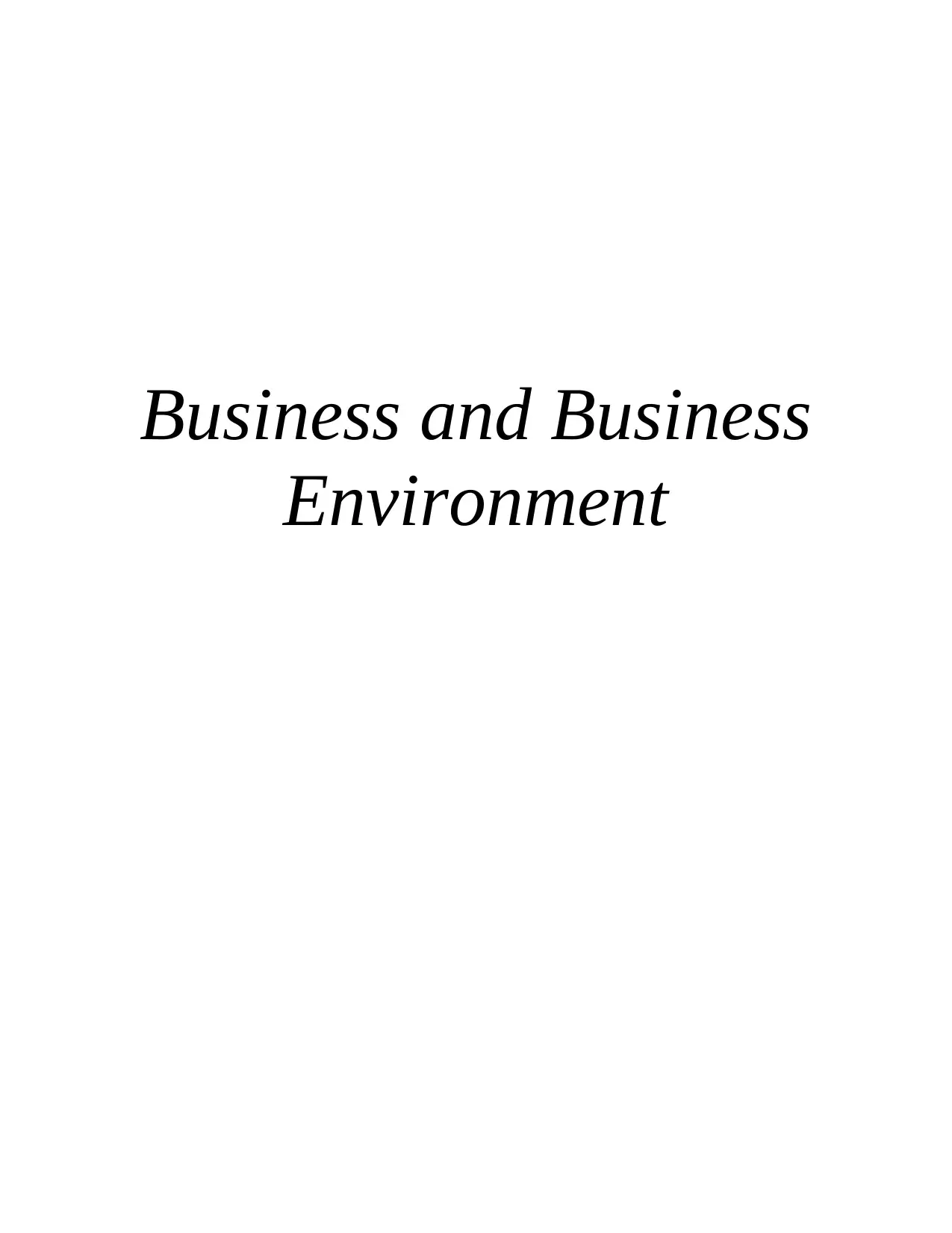
Business and Business
Environment
Environment
Paraphrase This Document
Need a fresh take? Get an instant paraphrase of this document with our AI Paraphraser
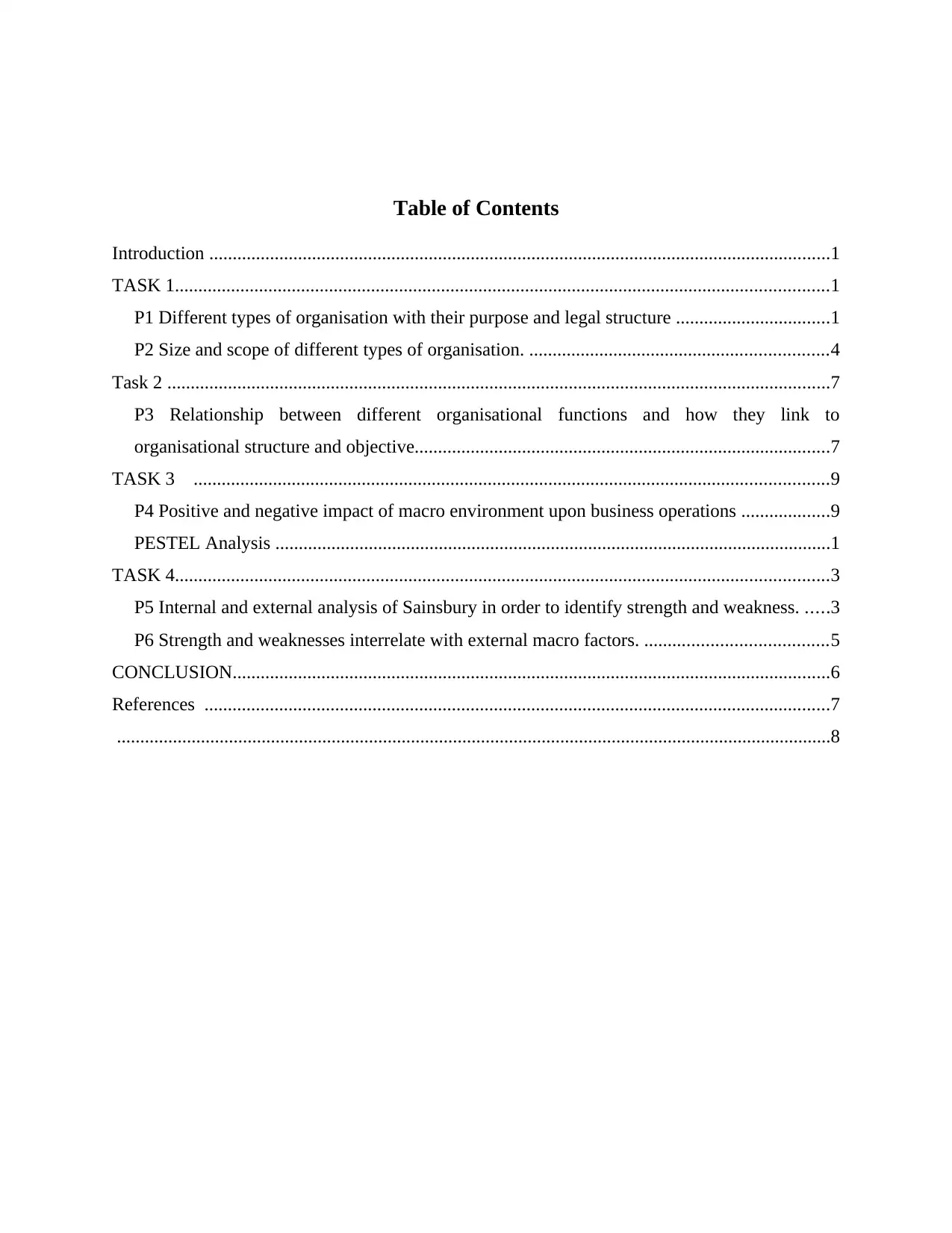
Table of Contents
Introduction .....................................................................................................................................1
TASK 1............................................................................................................................................1
P1 Different types of organisation with their purpose and legal structure .................................1
P2 Size and scope of different types of organisation. ................................................................4
Task 2 ..............................................................................................................................................7
P3 Relationship between different organisational functions and how they link to
organisational structure and objective.........................................................................................7
TASK 3 ........................................................................................................................................9
P4 Positive and negative impact of macro environment upon business operations ...................9
PESTEL Analysis .......................................................................................................................1
TASK 4............................................................................................................................................3
P5 Internal and external analysis of Sainsbury in order to identify strength and weakness. .....3
P6 Strength and weaknesses interrelate with external macro factors. .......................................5
CONCLUSION................................................................................................................................6
References ......................................................................................................................................7
.........................................................................................................................................................8
Introduction .....................................................................................................................................1
TASK 1............................................................................................................................................1
P1 Different types of organisation with their purpose and legal structure .................................1
P2 Size and scope of different types of organisation. ................................................................4
Task 2 ..............................................................................................................................................7
P3 Relationship between different organisational functions and how they link to
organisational structure and objective.........................................................................................7
TASK 3 ........................................................................................................................................9
P4 Positive and negative impact of macro environment upon business operations ...................9
PESTEL Analysis .......................................................................................................................1
TASK 4............................................................................................................................................3
P5 Internal and external analysis of Sainsbury in order to identify strength and weakness. .....3
P6 Strength and weaknesses interrelate with external macro factors. .......................................5
CONCLUSION................................................................................................................................6
References ......................................................................................................................................7
.........................................................................................................................................................8

⊘ This is a preview!⊘
Do you want full access?
Subscribe today to unlock all pages.

Trusted by 1+ million students worldwide
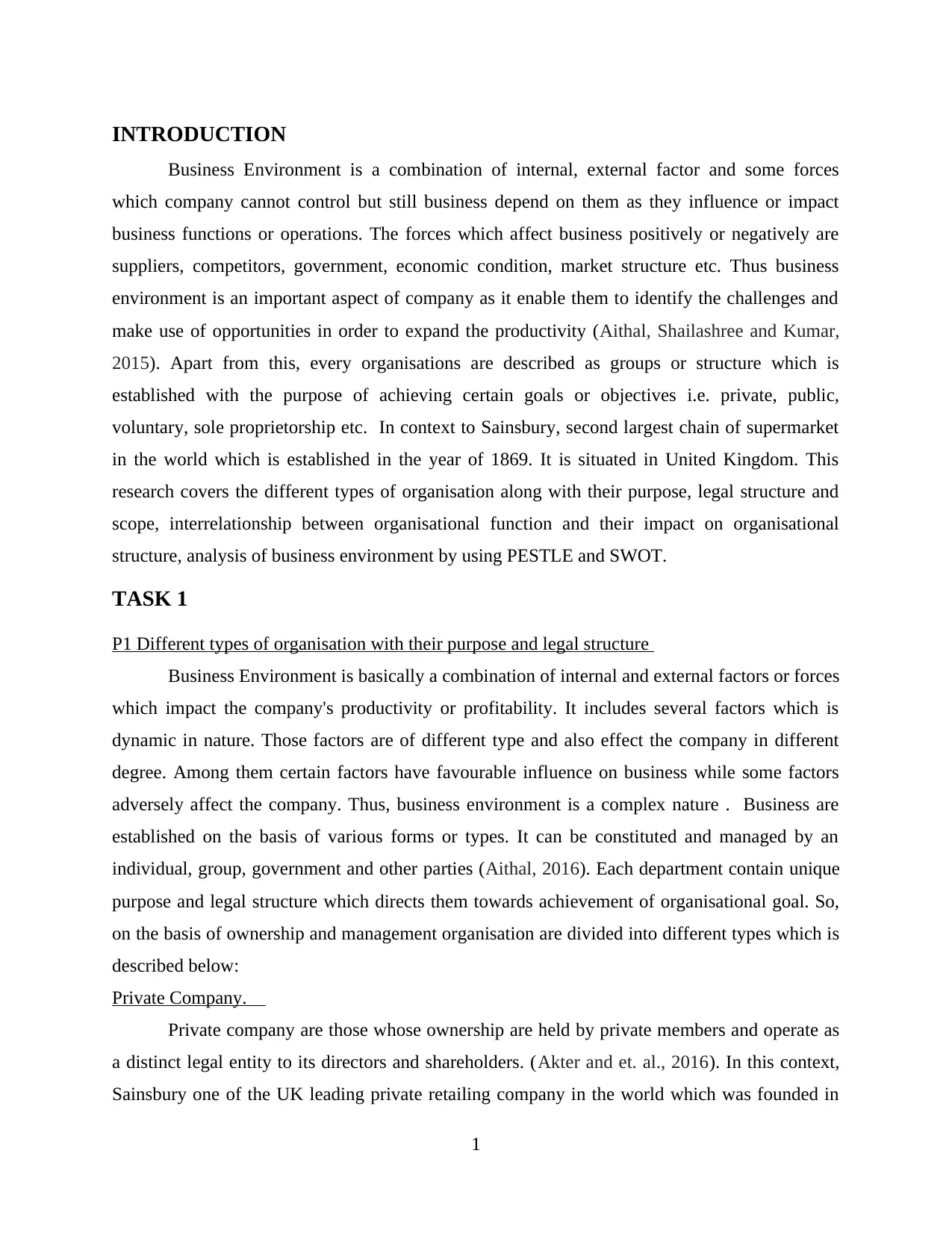
INTRODUCTION
Business Environment is a combination of internal, external factor and some forces
which company cannot control but still business depend on them as they influence or impact
business functions or operations. The forces which affect business positively or negatively are
suppliers, competitors, government, economic condition, market structure etc. Thus business
environment is an important aspect of company as it enable them to identify the challenges and
make use of opportunities in order to expand the productivity (Aithal, Shailashree and Kumar,
2015). Apart from this, every organisations are described as groups or structure which is
established with the purpose of achieving certain goals or objectives i.e. private, public,
voluntary, sole proprietorship etc. In context to Sainsbury, second largest chain of supermarket
in the world which is established in the year of 1869. It is situated in United Kingdom. This
research covers the different types of organisation along with their purpose, legal structure and
scope, interrelationship between organisational function and their impact on organisational
structure, analysis of business environment by using PESTLE and SWOT.
TASK 1
P1 Different types of organisation with their purpose and legal structure
Business Environment is basically a combination of internal and external factors or forces
which impact the company's productivity or profitability. It includes several factors which is
dynamic in nature. Those factors are of different type and also effect the company in different
degree. Among them certain factors have favourable influence on business while some factors
adversely affect the company. Thus, business environment is a complex nature . Business are
established on the basis of various forms or types. It can be constituted and managed by an
individual, group, government and other parties (Aithal, 2016). Each department contain unique
purpose and legal structure which directs them towards achievement of organisational goal. So,
on the basis of ownership and management organisation are divided into different types which is
described below:
Private Company.
Private company are those whose ownership are held by private members and operate as
a distinct legal entity to its directors and shareholders. (Akter and et. al., 2016). In this context,
Sainsbury one of the UK leading private retailing company in the world which was founded in
1
Business Environment is a combination of internal, external factor and some forces
which company cannot control but still business depend on them as they influence or impact
business functions or operations. The forces which affect business positively or negatively are
suppliers, competitors, government, economic condition, market structure etc. Thus business
environment is an important aspect of company as it enable them to identify the challenges and
make use of opportunities in order to expand the productivity (Aithal, Shailashree and Kumar,
2015). Apart from this, every organisations are described as groups or structure which is
established with the purpose of achieving certain goals or objectives i.e. private, public,
voluntary, sole proprietorship etc. In context to Sainsbury, second largest chain of supermarket
in the world which is established in the year of 1869. It is situated in United Kingdom. This
research covers the different types of organisation along with their purpose, legal structure and
scope, interrelationship between organisational function and their impact on organisational
structure, analysis of business environment by using PESTLE and SWOT.
TASK 1
P1 Different types of organisation with their purpose and legal structure
Business Environment is basically a combination of internal and external factors or forces
which impact the company's productivity or profitability. It includes several factors which is
dynamic in nature. Those factors are of different type and also effect the company in different
degree. Among them certain factors have favourable influence on business while some factors
adversely affect the company. Thus, business environment is a complex nature . Business are
established on the basis of various forms or types. It can be constituted and managed by an
individual, group, government and other parties (Aithal, 2016). Each department contain unique
purpose and legal structure which directs them towards achievement of organisational goal. So,
on the basis of ownership and management organisation are divided into different types which is
described below:
Private Company.
Private company are those whose ownership are held by private members and operate as
a distinct legal entity to its directors and shareholders. (Akter and et. al., 2016). In this context,
Sainsbury one of the UK leading private retailing company in the world which was founded in
1
Paraphrase This Document
Need a fresh take? Get an instant paraphrase of this document with our AI Paraphraser
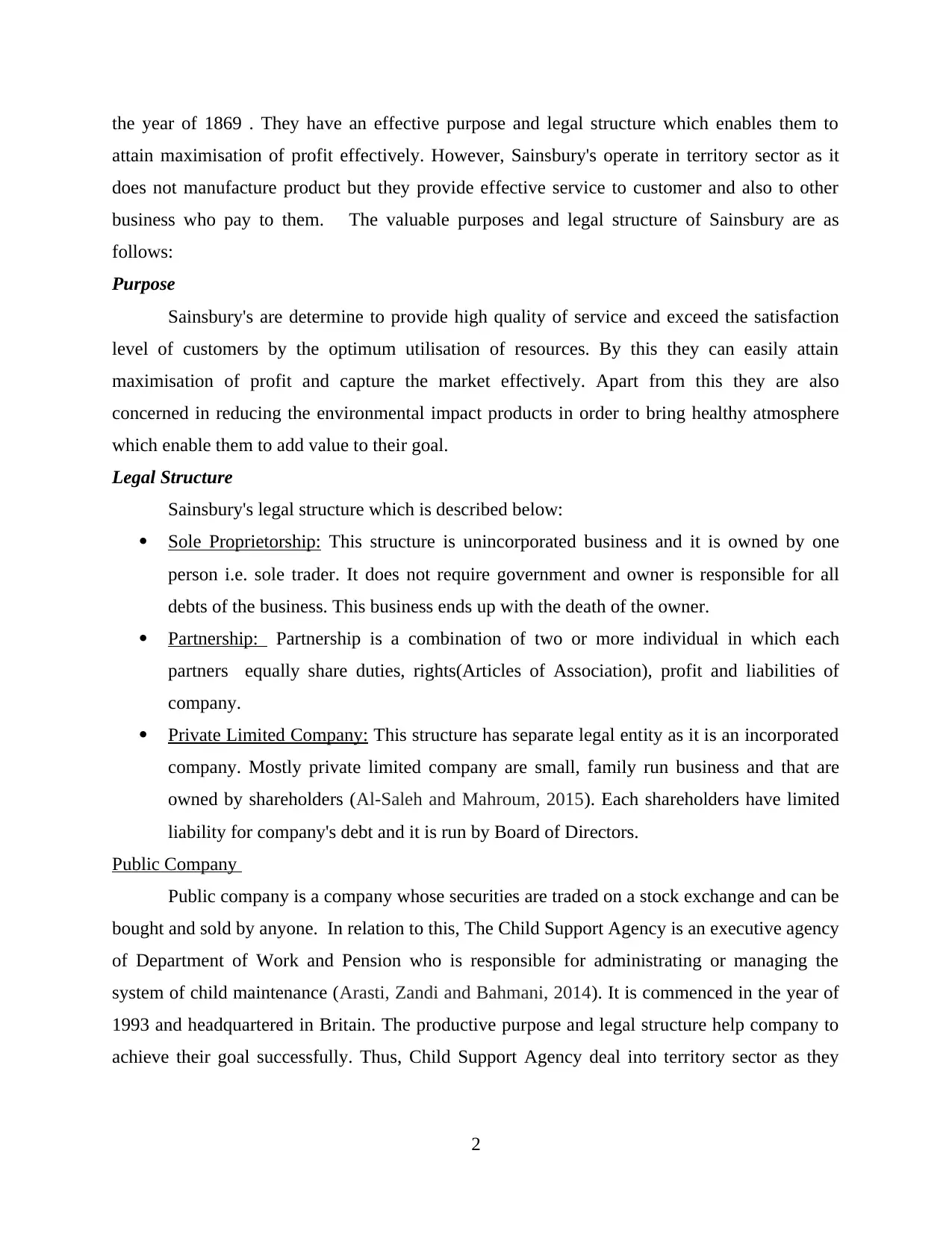
the year of 1869 . They have an effective purpose and legal structure which enables them to
attain maximisation of profit effectively. However, Sainsbury's operate in territory sector as it
does not manufacture product but they provide effective service to customer and also to other
business who pay to them. The valuable purposes and legal structure of Sainsbury are as
follows:
Purpose
Sainsbury's are determine to provide high quality of service and exceed the satisfaction
level of customers by the optimum utilisation of resources. By this they can easily attain
maximisation of profit and capture the market effectively. Apart from this they are also
concerned in reducing the environmental impact products in order to bring healthy atmosphere
which enable them to add value to their goal.
Legal Structure
Sainsbury's legal structure which is described below:
Sole Proprietorship: This structure is unincorporated business and it is owned by one
person i.e. sole trader. It does not require government and owner is responsible for all
debts of the business. This business ends up with the death of the owner.
Partnership: Partnership is a combination of two or more individual in which each
partners equally share duties, rights(Articles of Association), profit and liabilities of
company.
Private Limited Company: This structure has separate legal entity as it is an incorporated
company. Mostly private limited company are small, family run business and that are
owned by shareholders (Al-Saleh and Mahroum, 2015). Each shareholders have limited
liability for company's debt and it is run by Board of Directors.
Public Company
Public company is a company whose securities are traded on a stock exchange and can be
bought and sold by anyone. In relation to this, The Child Support Agency is an executive agency
of Department of Work and Pension who is responsible for administrating or managing the
system of child maintenance (Arasti, Zandi and Bahmani, 2014). It is commenced in the year of
1993 and headquartered in Britain. The productive purpose and legal structure help company to
achieve their goal successfully. Thus, Child Support Agency deal into territory sector as they
2
attain maximisation of profit effectively. However, Sainsbury's operate in territory sector as it
does not manufacture product but they provide effective service to customer and also to other
business who pay to them. The valuable purposes and legal structure of Sainsbury are as
follows:
Purpose
Sainsbury's are determine to provide high quality of service and exceed the satisfaction
level of customers by the optimum utilisation of resources. By this they can easily attain
maximisation of profit and capture the market effectively. Apart from this they are also
concerned in reducing the environmental impact products in order to bring healthy atmosphere
which enable them to add value to their goal.
Legal Structure
Sainsbury's legal structure which is described below:
Sole Proprietorship: This structure is unincorporated business and it is owned by one
person i.e. sole trader. It does not require government and owner is responsible for all
debts of the business. This business ends up with the death of the owner.
Partnership: Partnership is a combination of two or more individual in which each
partners equally share duties, rights(Articles of Association), profit and liabilities of
company.
Private Limited Company: This structure has separate legal entity as it is an incorporated
company. Mostly private limited company are small, family run business and that are
owned by shareholders (Al-Saleh and Mahroum, 2015). Each shareholders have limited
liability for company's debt and it is run by Board of Directors.
Public Company
Public company is a company whose securities are traded on a stock exchange and can be
bought and sold by anyone. In relation to this, The Child Support Agency is an executive agency
of Department of Work and Pension who is responsible for administrating or managing the
system of child maintenance (Arasti, Zandi and Bahmani, 2014). It is commenced in the year of
1993 and headquartered in Britain. The productive purpose and legal structure help company to
achieve their goal successfully. Thus, Child Support Agency deal into territory sector as they
2
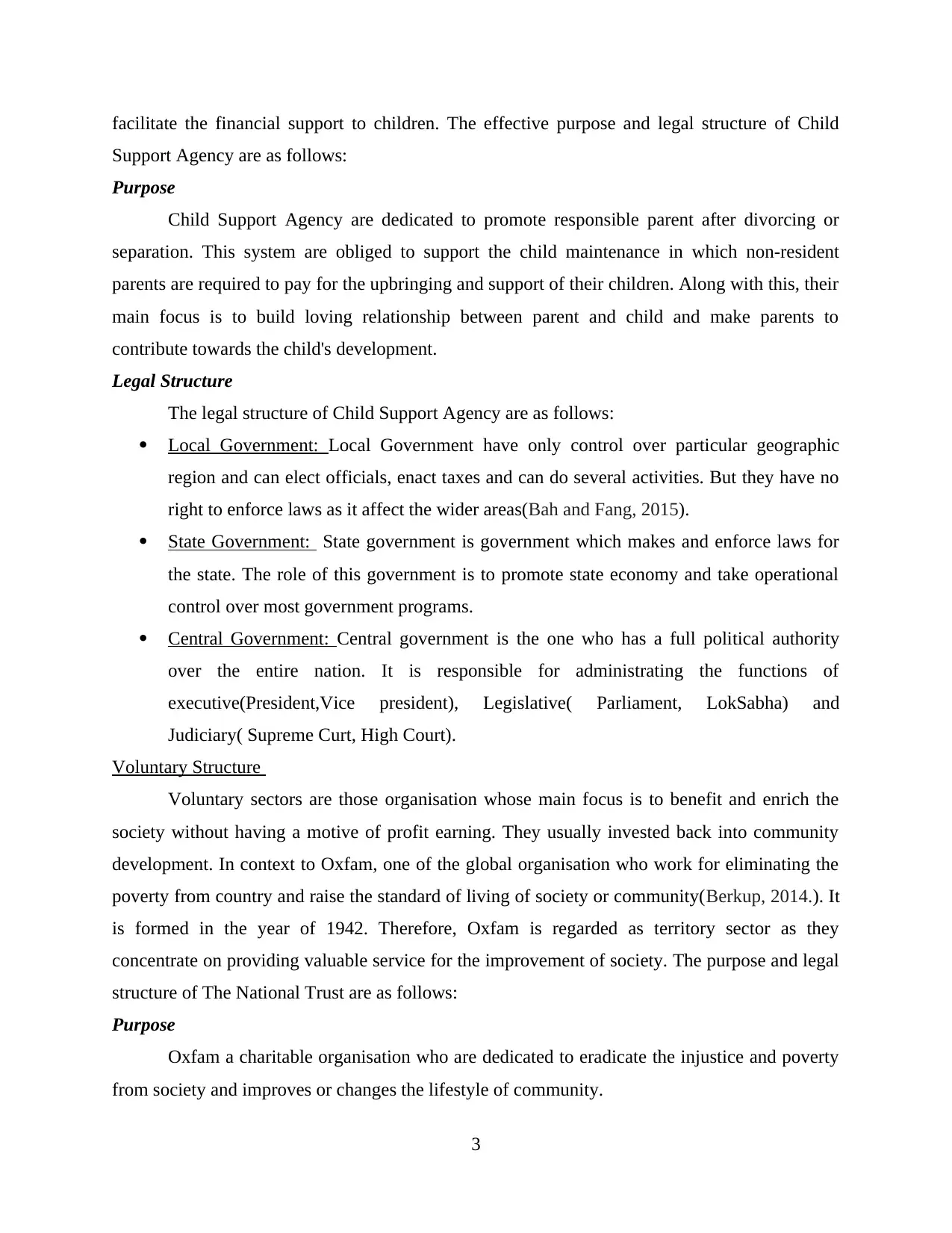
facilitate the financial support to children. The effective purpose and legal structure of Child
Support Agency are as follows:
Purpose
Child Support Agency are dedicated to promote responsible parent after divorcing or
separation. This system are obliged to support the child maintenance in which non-resident
parents are required to pay for the upbringing and support of their children. Along with this, their
main focus is to build loving relationship between parent and child and make parents to
contribute towards the child's development.
Legal Structure
The legal structure of Child Support Agency are as follows:
Local Government: Local Government have only control over particular geographic
region and can elect officials, enact taxes and can do several activities. But they have no
right to enforce laws as it affect the wider areas(Bah and Fang, 2015).
State Government: State government is government which makes and enforce laws for
the state. The role of this government is to promote state economy and take operational
control over most government programs.
Central Government: Central government is the one who has a full political authority
over the entire nation. It is responsible for administrating the functions of
executive(President,Vice president), Legislative( Parliament, LokSabha) and
Judiciary( Supreme Curt, High Court).
Voluntary Structure
Voluntary sectors are those organisation whose main focus is to benefit and enrich the
society without having a motive of profit earning. They usually invested back into community
development. In context to Oxfam, one of the global organisation who work for eliminating the
poverty from country and raise the standard of living of society or community(Berkup, 2014.). It
is formed in the year of 1942. Therefore, Oxfam is regarded as territory sector as they
concentrate on providing valuable service for the improvement of society. The purpose and legal
structure of The National Trust are as follows:
Purpose
Oxfam a charitable organisation who are dedicated to eradicate the injustice and poverty
from society and improves or changes the lifestyle of community.
3
Support Agency are as follows:
Purpose
Child Support Agency are dedicated to promote responsible parent after divorcing or
separation. This system are obliged to support the child maintenance in which non-resident
parents are required to pay for the upbringing and support of their children. Along with this, their
main focus is to build loving relationship between parent and child and make parents to
contribute towards the child's development.
Legal Structure
The legal structure of Child Support Agency are as follows:
Local Government: Local Government have only control over particular geographic
region and can elect officials, enact taxes and can do several activities. But they have no
right to enforce laws as it affect the wider areas(Bah and Fang, 2015).
State Government: State government is government which makes and enforce laws for
the state. The role of this government is to promote state economy and take operational
control over most government programs.
Central Government: Central government is the one who has a full political authority
over the entire nation. It is responsible for administrating the functions of
executive(President,Vice president), Legislative( Parliament, LokSabha) and
Judiciary( Supreme Curt, High Court).
Voluntary Structure
Voluntary sectors are those organisation whose main focus is to benefit and enrich the
society without having a motive of profit earning. They usually invested back into community
development. In context to Oxfam, one of the global organisation who work for eliminating the
poverty from country and raise the standard of living of society or community(Berkup, 2014.). It
is formed in the year of 1942. Therefore, Oxfam is regarded as territory sector as they
concentrate on providing valuable service for the improvement of society. The purpose and legal
structure of The National Trust are as follows:
Purpose
Oxfam a charitable organisation who are dedicated to eradicate the injustice and poverty
from society and improves or changes the lifestyle of community.
3
⊘ This is a preview!⊘
Do you want full access?
Subscribe today to unlock all pages.

Trusted by 1+ million students worldwide
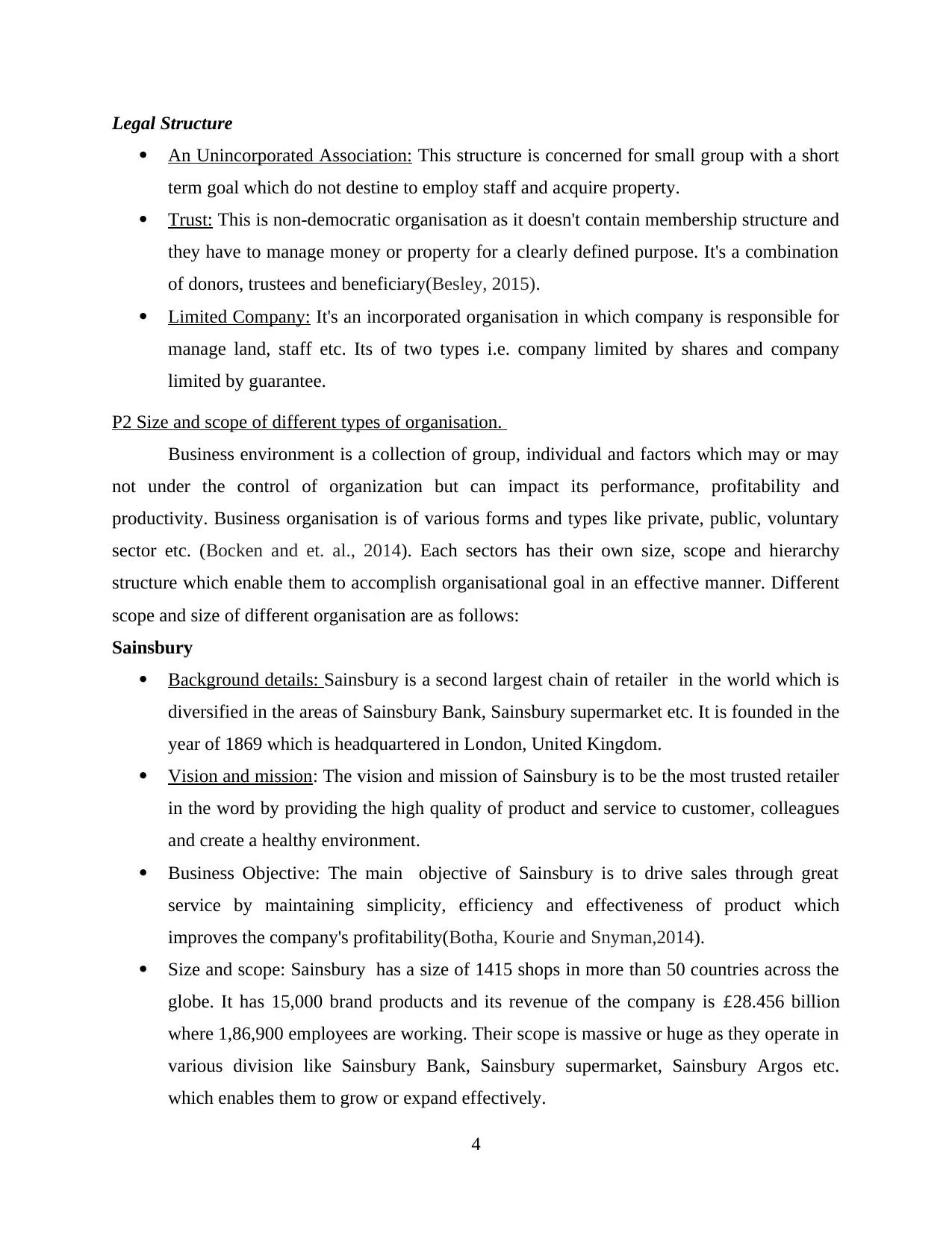
Legal Structure
An Unincorporated Association: This structure is concerned for small group with a short
term goal which do not destine to employ staff and acquire property.
Trust: This is non-democratic organisation as it doesn't contain membership structure and
they have to manage money or property for a clearly defined purpose. It's a combination
of donors, trustees and beneficiary(Besley, 2015).
Limited Company: It's an incorporated organisation in which company is responsible for
manage land, staff etc. Its of two types i.e. company limited by shares and company
limited by guarantee.
P2 Size and scope of different types of organisation.
Business environment is a collection of group, individual and factors which may or may
not under the control of organization but can impact its performance, profitability and
productivity. Business organisation is of various forms and types like private, public, voluntary
sector etc. (Bocken and et. al., 2014). Each sectors has their own size, scope and hierarchy
structure which enable them to accomplish organisational goal in an effective manner. Different
scope and size of different organisation are as follows:
Sainsbury
Background details: Sainsbury is a second largest chain of retailer in the world which is
diversified in the areas of Sainsbury Bank, Sainsbury supermarket etc. It is founded in the
year of 1869 which is headquartered in London, United Kingdom.
Vision and mission: The vision and mission of Sainsbury is to be the most trusted retailer
in the word by providing the high quality of product and service to customer, colleagues
and create a healthy environment.
Business Objective: The main objective of Sainsbury is to drive sales through great
service by maintaining simplicity, efficiency and effectiveness of product which
improves the company's profitability(Botha, Kourie and Snyman,2014).
Size and scope: Sainsbury has a size of 1415 shops in more than 50 countries across the
globe. It has 15,000 brand products and its revenue of the company is £28.456 billion
where 1,86,900 employees are working. Their scope is massive or huge as they operate in
various division like Sainsbury Bank, Sainsbury supermarket, Sainsbury Argos etc.
which enables them to grow or expand effectively.
4
An Unincorporated Association: This structure is concerned for small group with a short
term goal which do not destine to employ staff and acquire property.
Trust: This is non-democratic organisation as it doesn't contain membership structure and
they have to manage money or property for a clearly defined purpose. It's a combination
of donors, trustees and beneficiary(Besley, 2015).
Limited Company: It's an incorporated organisation in which company is responsible for
manage land, staff etc. Its of two types i.e. company limited by shares and company
limited by guarantee.
P2 Size and scope of different types of organisation.
Business environment is a collection of group, individual and factors which may or may
not under the control of organization but can impact its performance, profitability and
productivity. Business organisation is of various forms and types like private, public, voluntary
sector etc. (Bocken and et. al., 2014). Each sectors has their own size, scope and hierarchy
structure which enable them to accomplish organisational goal in an effective manner. Different
scope and size of different organisation are as follows:
Sainsbury
Background details: Sainsbury is a second largest chain of retailer in the world which is
diversified in the areas of Sainsbury Bank, Sainsbury supermarket etc. It is founded in the
year of 1869 which is headquartered in London, United Kingdom.
Vision and mission: The vision and mission of Sainsbury is to be the most trusted retailer
in the word by providing the high quality of product and service to customer, colleagues
and create a healthy environment.
Business Objective: The main objective of Sainsbury is to drive sales through great
service by maintaining simplicity, efficiency and effectiveness of product which
improves the company's profitability(Botha, Kourie and Snyman,2014).
Size and scope: Sainsbury has a size of 1415 shops in more than 50 countries across the
globe. It has 15,000 brand products and its revenue of the company is £28.456 billion
where 1,86,900 employees are working. Their scope is massive or huge as they operate in
various division like Sainsbury Bank, Sainsbury supermarket, Sainsbury Argos etc.
which enables them to grow or expand effectively.
4
Paraphrase This Document
Need a fresh take? Get an instant paraphrase of this document with our AI Paraphraser
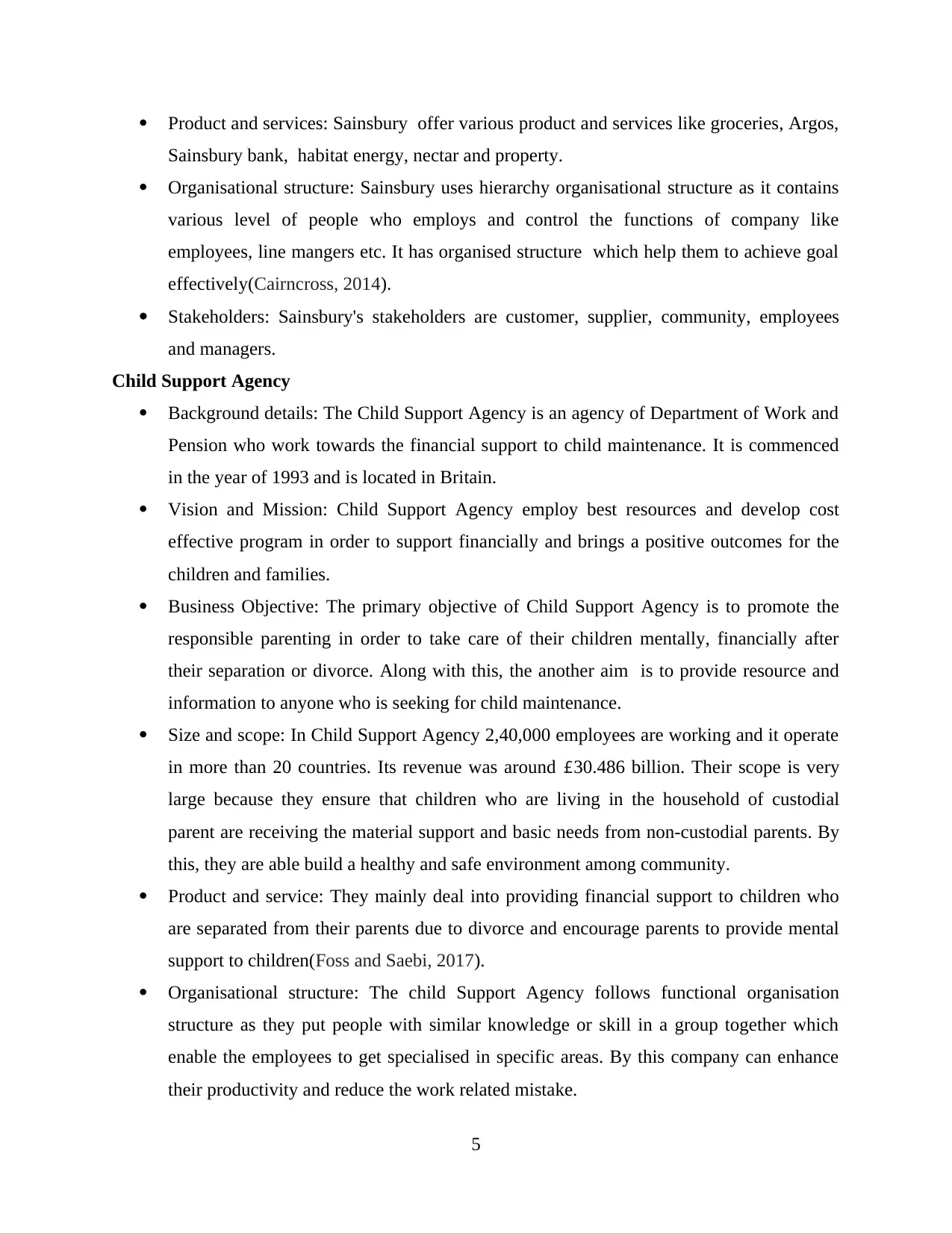
Product and services: Sainsbury offer various product and services like groceries, Argos,
Sainsbury bank, habitat energy, nectar and property.
Organisational structure: Sainsbury uses hierarchy organisational structure as it contains
various level of people who employs and control the functions of company like
employees, line mangers etc. It has organised structure which help them to achieve goal
effectively(Cairncross, 2014).
Stakeholders: Sainsbury's stakeholders are customer, supplier, community, employees
and managers.
Child Support Agency
Background details: The Child Support Agency is an agency of Department of Work and
Pension who work towards the financial support to child maintenance. It is commenced
in the year of 1993 and is located in Britain.
Vision and Mission: Child Support Agency employ best resources and develop cost
effective program in order to support financially and brings a positive outcomes for the
children and families.
Business Objective: The primary objective of Child Support Agency is to promote the
responsible parenting in order to take care of their children mentally, financially after
their separation or divorce. Along with this, the another aim is to provide resource and
information to anyone who is seeking for child maintenance.
Size and scope: In Child Support Agency 2,40,000 employees are working and it operate
in more than 20 countries. Its revenue was around £30.486 billion. Their scope is very
large because they ensure that children who are living in the household of custodial
parent are receiving the material support and basic needs from non-custodial parents. By
this, they are able build a healthy and safe environment among community.
Product and service: They mainly deal into providing financial support to children who
are separated from their parents due to divorce and encourage parents to provide mental
support to children(Foss and Saebi, 2017).
Organisational structure: The child Support Agency follows functional organisation
structure as they put people with similar knowledge or skill in a group together which
enable the employees to get specialised in specific areas. By this company can enhance
their productivity and reduce the work related mistake.
5
Sainsbury bank, habitat energy, nectar and property.
Organisational structure: Sainsbury uses hierarchy organisational structure as it contains
various level of people who employs and control the functions of company like
employees, line mangers etc. It has organised structure which help them to achieve goal
effectively(Cairncross, 2014).
Stakeholders: Sainsbury's stakeholders are customer, supplier, community, employees
and managers.
Child Support Agency
Background details: The Child Support Agency is an agency of Department of Work and
Pension who work towards the financial support to child maintenance. It is commenced
in the year of 1993 and is located in Britain.
Vision and Mission: Child Support Agency employ best resources and develop cost
effective program in order to support financially and brings a positive outcomes for the
children and families.
Business Objective: The primary objective of Child Support Agency is to promote the
responsible parenting in order to take care of their children mentally, financially after
their separation or divorce. Along with this, the another aim is to provide resource and
information to anyone who is seeking for child maintenance.
Size and scope: In Child Support Agency 2,40,000 employees are working and it operate
in more than 20 countries. Its revenue was around £30.486 billion. Their scope is very
large because they ensure that children who are living in the household of custodial
parent are receiving the material support and basic needs from non-custodial parents. By
this, they are able build a healthy and safe environment among community.
Product and service: They mainly deal into providing financial support to children who
are separated from their parents due to divorce and encourage parents to provide mental
support to children(Foss and Saebi, 2017).
Organisational structure: The child Support Agency follows functional organisation
structure as they put people with similar knowledge or skill in a group together which
enable the employees to get specialised in specific areas. By this company can enhance
their productivity and reduce the work related mistake.
5
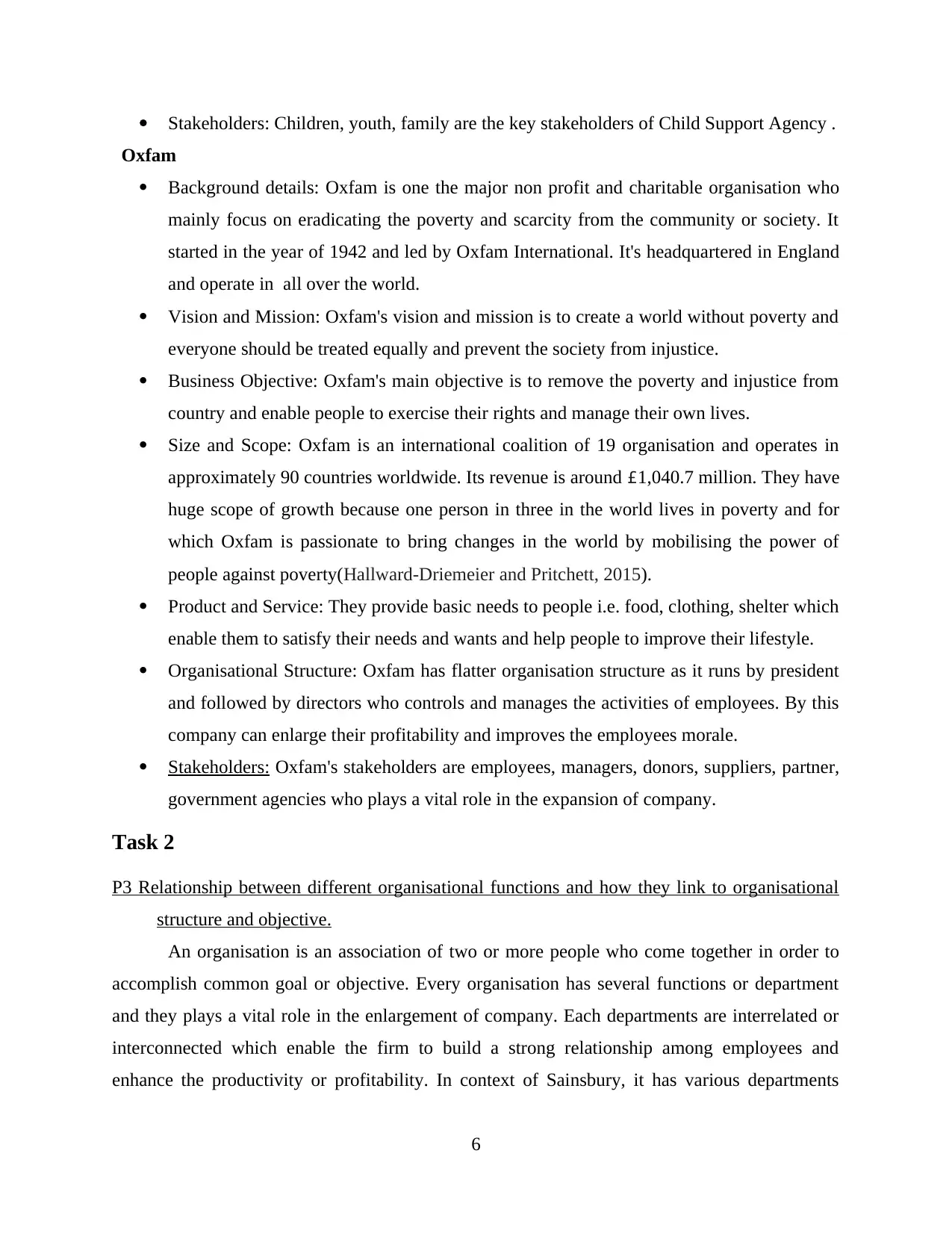
Stakeholders: Children, youth, family are the key stakeholders of Child Support Agency .
Oxfam
Background details: Oxfam is one the major non profit and charitable organisation who
mainly focus on eradicating the poverty and scarcity from the community or society. It
started in the year of 1942 and led by Oxfam International. It's headquartered in England
and operate in all over the world.
Vision and Mission: Oxfam's vision and mission is to create a world without poverty and
everyone should be treated equally and prevent the society from injustice.
Business Objective: Oxfam's main objective is to remove the poverty and injustice from
country and enable people to exercise their rights and manage their own lives.
Size and Scope: Oxfam is an international coalition of 19 organisation and operates in
approximately 90 countries worldwide. Its revenue is around £1,040.7 million. They have
huge scope of growth because one person in three in the world lives in poverty and for
which Oxfam is passionate to bring changes in the world by mobilising the power of
people against poverty(Hallward-Driemeier and Pritchett, 2015).
Product and Service: They provide basic needs to people i.e. food, clothing, shelter which
enable them to satisfy their needs and wants and help people to improve their lifestyle.
Organisational Structure: Oxfam has flatter organisation structure as it runs by president
and followed by directors who controls and manages the activities of employees. By this
company can enlarge their profitability and improves the employees morale.
Stakeholders: Oxfam's stakeholders are employees, managers, donors, suppliers, partner,
government agencies who plays a vital role in the expansion of company.
Task 2
P3 Relationship between different organisational functions and how they link to organisational
structure and objective.
An organisation is an association of two or more people who come together in order to
accomplish common goal or objective. Every organisation has several functions or department
and they plays a vital role in the enlargement of company. Each departments are interrelated or
interconnected which enable the firm to build a strong relationship among employees and
enhance the productivity or profitability. In context of Sainsbury, it has various departments
6
Oxfam
Background details: Oxfam is one the major non profit and charitable organisation who
mainly focus on eradicating the poverty and scarcity from the community or society. It
started in the year of 1942 and led by Oxfam International. It's headquartered in England
and operate in all over the world.
Vision and Mission: Oxfam's vision and mission is to create a world without poverty and
everyone should be treated equally and prevent the society from injustice.
Business Objective: Oxfam's main objective is to remove the poverty and injustice from
country and enable people to exercise their rights and manage their own lives.
Size and Scope: Oxfam is an international coalition of 19 organisation and operates in
approximately 90 countries worldwide. Its revenue is around £1,040.7 million. They have
huge scope of growth because one person in three in the world lives in poverty and for
which Oxfam is passionate to bring changes in the world by mobilising the power of
people against poverty(Hallward-Driemeier and Pritchett, 2015).
Product and Service: They provide basic needs to people i.e. food, clothing, shelter which
enable them to satisfy their needs and wants and help people to improve their lifestyle.
Organisational Structure: Oxfam has flatter organisation structure as it runs by president
and followed by directors who controls and manages the activities of employees. By this
company can enlarge their profitability and improves the employees morale.
Stakeholders: Oxfam's stakeholders are employees, managers, donors, suppliers, partner,
government agencies who plays a vital role in the expansion of company.
Task 2
P3 Relationship between different organisational functions and how they link to organisational
structure and objective.
An organisation is an association of two or more people who come together in order to
accomplish common goal or objective. Every organisation has several functions or department
and they plays a vital role in the enlargement of company. Each departments are interrelated or
interconnected which enable the firm to build a strong relationship among employees and
enhance the productivity or profitability. In context of Sainsbury, it has various departments
6
⊘ This is a preview!⊘
Do you want full access?
Subscribe today to unlock all pages.

Trusted by 1+ million students worldwide
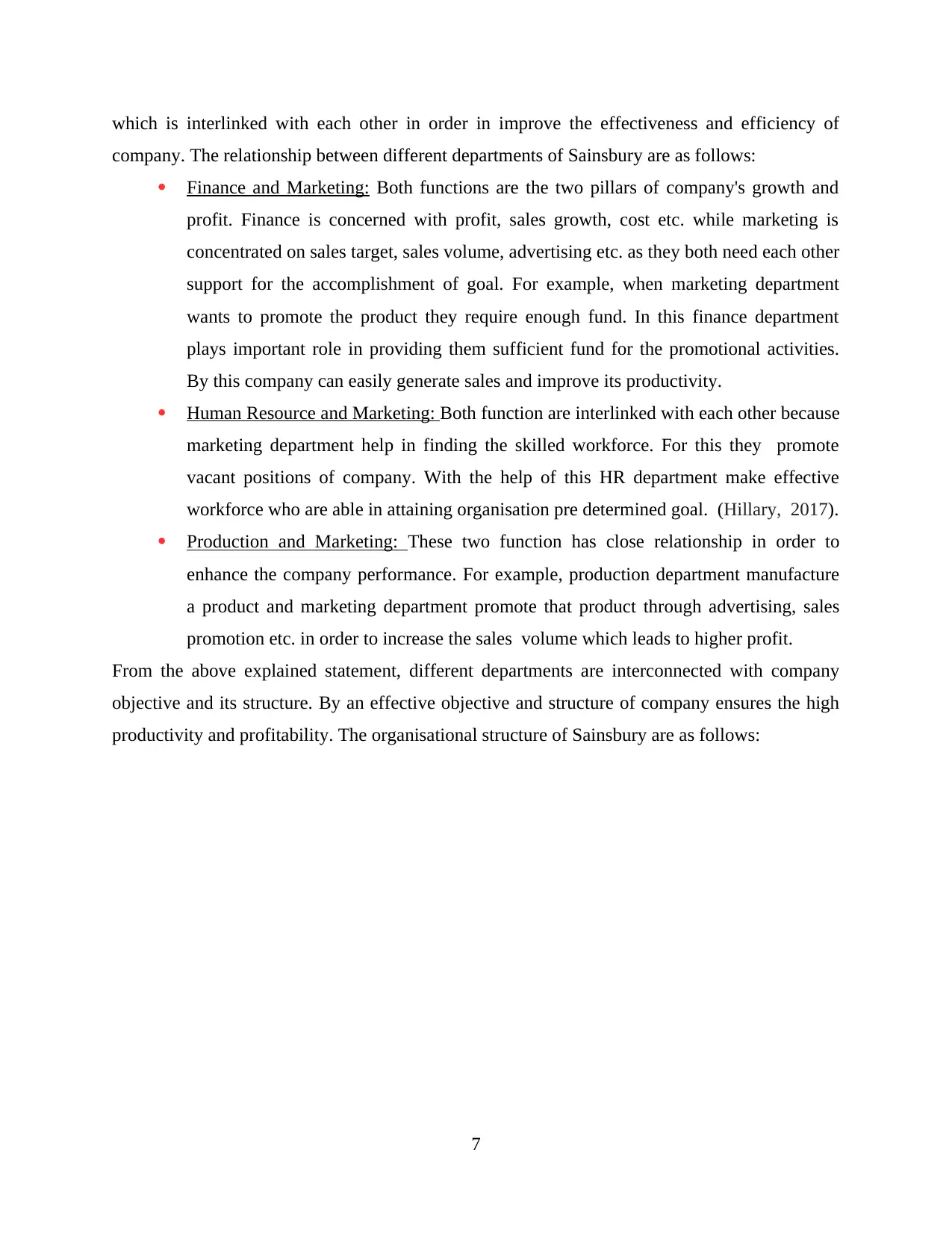
which is interlinked with each other in order in improve the effectiveness and efficiency of
company. The relationship between different departments of Sainsbury are as follows:
Finance and Marketing: Both functions are the two pillars of company's growth and
profit. Finance is concerned with profit, sales growth, cost etc. while marketing is
concentrated on sales target, sales volume, advertising etc. as they both need each other
support for the accomplishment of goal. For example, when marketing department
wants to promote the product they require enough fund. In this finance department
plays important role in providing them sufficient fund for the promotional activities.
By this company can easily generate sales and improve its productivity.
Human Resource and Marketing: Both function are interlinked with each other because
marketing department help in finding the skilled workforce. For this they promote
vacant positions of company. With the help of this HR department make effective
workforce who are able in attaining organisation pre determined goal. (Hillary, 2017).
Production and Marketing: These two function has close relationship in order to
enhance the company performance. For example, production department manufacture
a product and marketing department promote that product through advertising, sales
promotion etc. in order to increase the sales volume which leads to higher profit.
From the above explained statement, different departments are interconnected with company
objective and its structure. By an effective objective and structure of company ensures the high
productivity and profitability. The organisational structure of Sainsbury are as follows:
7
company. The relationship between different departments of Sainsbury are as follows:
Finance and Marketing: Both functions are the two pillars of company's growth and
profit. Finance is concerned with profit, sales growth, cost etc. while marketing is
concentrated on sales target, sales volume, advertising etc. as they both need each other
support for the accomplishment of goal. For example, when marketing department
wants to promote the product they require enough fund. In this finance department
plays important role in providing them sufficient fund for the promotional activities.
By this company can easily generate sales and improve its productivity.
Human Resource and Marketing: Both function are interlinked with each other because
marketing department help in finding the skilled workforce. For this they promote
vacant positions of company. With the help of this HR department make effective
workforce who are able in attaining organisation pre determined goal. (Hillary, 2017).
Production and Marketing: These two function has close relationship in order to
enhance the company performance. For example, production department manufacture
a product and marketing department promote that product through advertising, sales
promotion etc. in order to increase the sales volume which leads to higher profit.
From the above explained statement, different departments are interconnected with company
objective and its structure. By an effective objective and structure of company ensures the high
productivity and profitability. The organisational structure of Sainsbury are as follows:
7
Paraphrase This Document
Need a fresh take? Get an instant paraphrase of this document with our AI Paraphraser
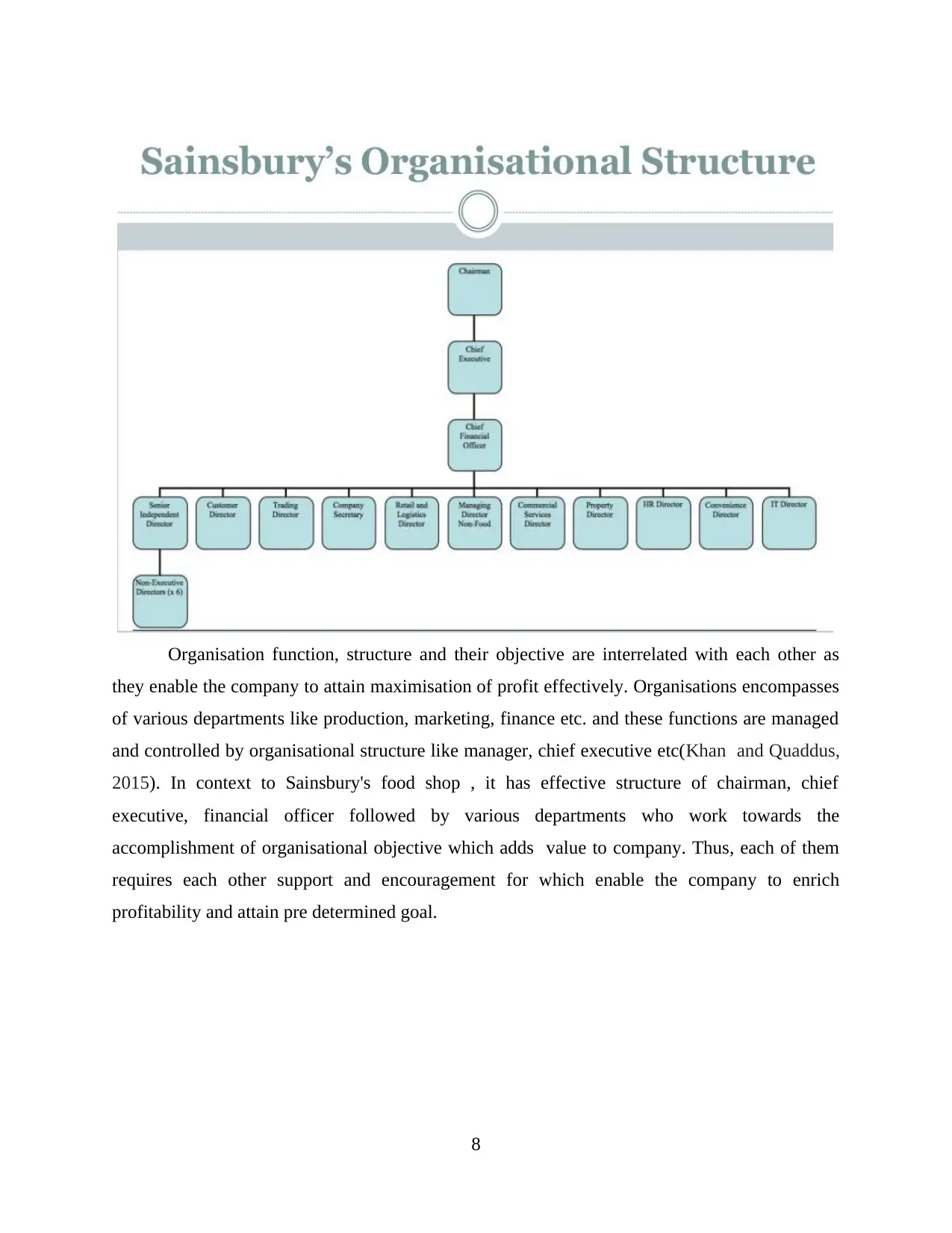
Organisation function, structure and their objective are interrelated with each other as
they enable the company to attain maximisation of profit effectively. Organisations encompasses
of various departments like production, marketing, finance etc. and these functions are managed
and controlled by organisational structure like manager, chief executive etc(Khan and Quaddus,
2015). In context to Sainsbury's food shop , it has effective structure of chairman, chief
executive, financial officer followed by various departments who work towards the
accomplishment of organisational objective which adds value to company. Thus, each of them
requires each other support and encouragement for which enable the company to enrich
profitability and attain pre determined goal.
8
they enable the company to attain maximisation of profit effectively. Organisations encompasses
of various departments like production, marketing, finance etc. and these functions are managed
and controlled by organisational structure like manager, chief executive etc(Khan and Quaddus,
2015). In context to Sainsbury's food shop , it has effective structure of chairman, chief
executive, financial officer followed by various departments who work towards the
accomplishment of organisational objective which adds value to company. Thus, each of them
requires each other support and encouragement for which enable the company to enrich
profitability and attain pre determined goal.
8
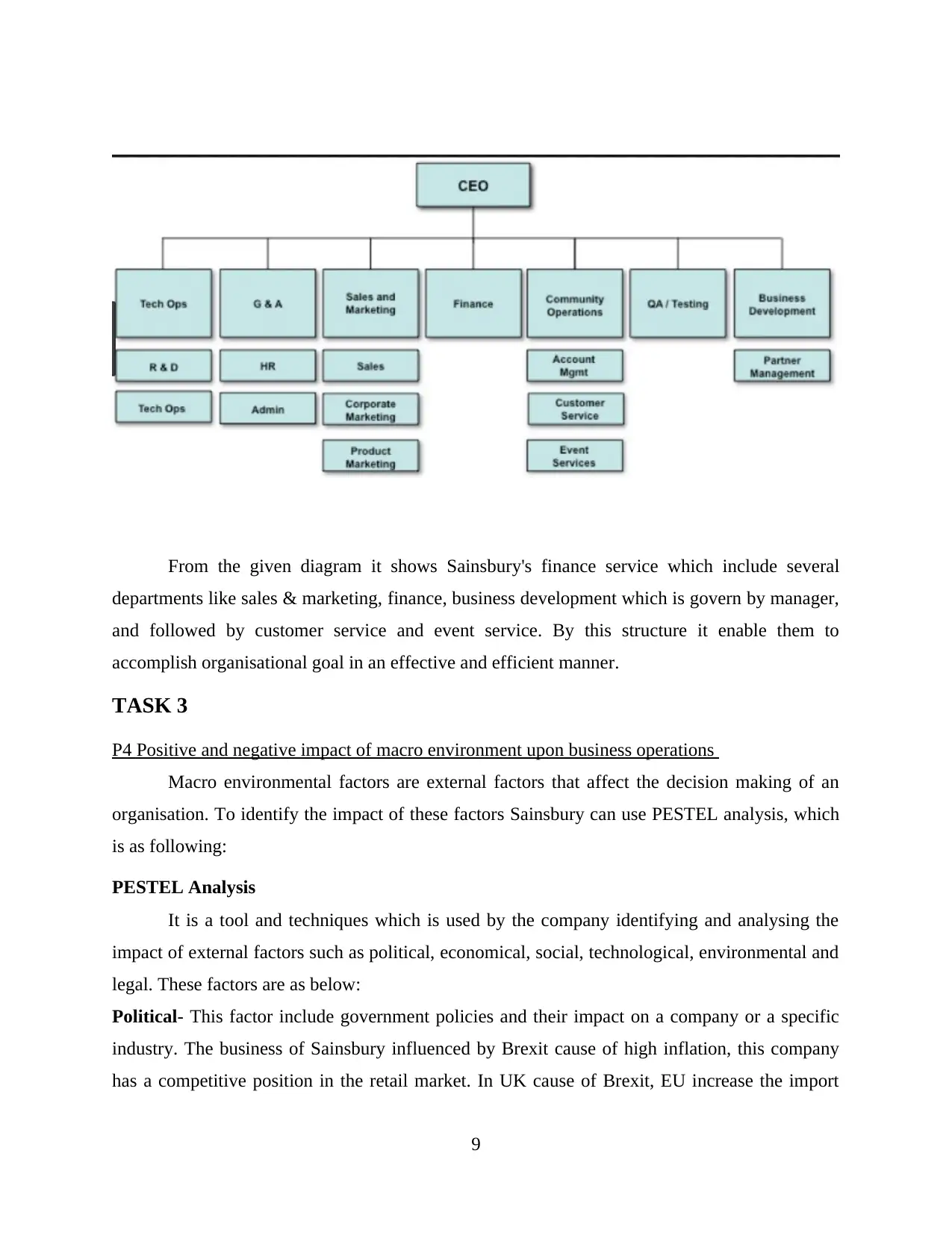
From the given diagram it shows Sainsbury's finance service which include several
departments like sales & marketing, finance, business development which is govern by manager,
and followed by customer service and event service. By this structure it enable them to
accomplish organisational goal in an effective and efficient manner.
TASK 3
P4 Positive and negative impact of macro environment upon business operations
Macro environmental factors are external factors that affect the decision making of an
organisation. To identify the impact of these factors Sainsbury can use PESTEL analysis, which
is as following:
PESTEL Analysis
It is a tool and techniques which is used by the company identifying and analysing the
impact of external factors such as political, economical, social, technological, environmental and
legal. These factors are as below:
Political- This factor include government policies and their impact on a company or a specific
industry. The business of Sainsbury influenced by Brexit cause of high inflation, this company
has a competitive position in the retail market. In UK cause of Brexit, EU increase the import
9
departments like sales & marketing, finance, business development which is govern by manager,
and followed by customer service and event service. By this structure it enable them to
accomplish organisational goal in an effective and efficient manner.
TASK 3
P4 Positive and negative impact of macro environment upon business operations
Macro environmental factors are external factors that affect the decision making of an
organisation. To identify the impact of these factors Sainsbury can use PESTEL analysis, which
is as following:
PESTEL Analysis
It is a tool and techniques which is used by the company identifying and analysing the
impact of external factors such as political, economical, social, technological, environmental and
legal. These factors are as below:
Political- This factor include government policies and their impact on a company or a specific
industry. The business of Sainsbury influenced by Brexit cause of high inflation, this company
has a competitive position in the retail market. In UK cause of Brexit, EU increase the import
9
⊘ This is a preview!⊘
Do you want full access?
Subscribe today to unlock all pages.

Trusted by 1+ million students worldwide
1 out of 21
Related Documents
Your All-in-One AI-Powered Toolkit for Academic Success.
+13062052269
info@desklib.com
Available 24*7 on WhatsApp / Email
![[object Object]](/_next/static/media/star-bottom.7253800d.svg)
Unlock your academic potential
Copyright © 2020–2025 A2Z Services. All Rights Reserved. Developed and managed by ZUCOL.





